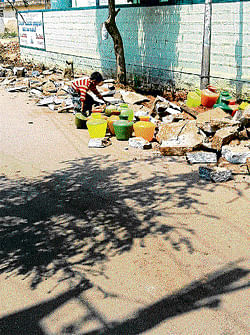
While the ISRO Telemetry, Tracking and Command (ISTRAC) Network in Peenya is looking for water on the moon, Chokkasandra residents are just looking for it around their homes.The ISTRAC network was responsible for keeping track of Chandrayaan – India’s first satellite around the moon, until its demise late last year. Among its many achievements, the mission confirmed the presence of water on the moon.
Take Shanthamma V, a homemaker in a household of six people, who lives at a stone’s throw away from the ISTRAC . She cannot help but smirk at the irony of the situation.
“When the newspapers began to carry news about the discovery of water by Chandrayaan, my neighbours use to crack jokes on shifting to the moon”, she says.
“Others would kid about how the water tankers would now look to the moon once the water from the ground runs out”, she adds.
Though Shanthamma jokes about this, meeting the needs of six of her family is no laughing matter. The supply pipes to her one-bedroom house in Chokkasandra have gone dry since the beginning of summer. “My husband and son have to leave for work at 8 am everyday. So, I and my two daughters wake up at 6 am and queue up with plastic pots at a water pipe down the street to bring water”, she says. In the afternoon, when her daughters go for classes, she gets water with the help of her four-year-old son.
Priority for industries
Chokkasandra, which falls in the Dasarahalli constituency, was added to Bruhat Bangalore Mahanagara Palike (BBMP) only two years ago.
Says Suresh Y G, an entrepreneur from Dasarahalli: “There has been no change in the availability of water even after the area came under BBMP. Cauvery water is available for industries around this area, but there is no water for the residents.”
Peenya Industrial area, one of the largest industrial suburbs in the world, receives Cauvery water from the BWSSB, but the residents are yet to see the benefit. John T, a engineering student, residing in Hesaraghatta, says: “What is the point if the government first serves industry’s needs before meeting the needs of the local people?” With the State government announcing plans to expand the industrial area even further, most residents expect the situation to get even worse.
Dasarahalli’s woes are worsened as even the water from borewells is unfit for drinking purposes. “The water is brackish and has a salty taste. To get drinking water, tankers get water from villages from the outskirts of the City where the water is much sweeter”, says Suresh. Typically, families shell out Rs 150 for a single supply of water by tankers. “But, how many families can afford it on a regular basis?” he asks.
Pinning hopes on Cauvery
However, residents are hopeful that with the completion of the Cauvery Phase IV, Stage II, they will finally get water for their houses. The Rs 3,300-crore project will supply 500 MLD (million litres per day) of water.
While the project was accorded approval by the government in 2005, and scheduled to be completed by 2009, delay has now pushed the deadline to 2012.
It is estimated that Bangalore requires about 1,225 MLD water. Currently, the BWSSB manages to supply 890 MLD. The shortage is much more due to leakages in water supply. Currently, the Cauvery water has been the lifeline of the City, with stage I, II and III bringing a total of 540 MLD of water. The first phase of stage IV will bring in 270 MLD water.